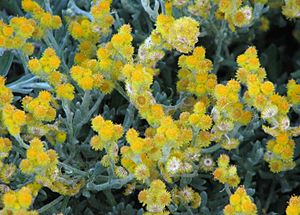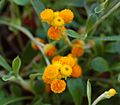Everlastings facts for kids
Quick facts for kids everlastings |
|
|---|---|
 |
|
| Chrysocephalum apiculatum | |
| Scientific classification | |
| Kingdom: | |
| (unranked): | |
| (unranked): | |
| (unranked): | |
| Order: | |
| Family: | |
| Tribe: |
Gnaphalieae
|
| Genus: |
Chrysocephalum
Walp.
|
| Synonyms | |
|
|
Chrysocephalum is a group of flowering plants often called everlastings. They get this name because their flowers last a very long time, even after they are cut! These plants belong to the Asteraceae family, which also includes sunflowers and daisies.
There are several types, or species, of Chrysocephalum. All of them grow naturally only in Australia.
What are Everlastings?
Everlastings are special because their flowers keep their shape and color for a long time. This is why people often use them as cut flowers in bouquets. They are also popular in dried flower arrangements.
These plants were once grouped with other similar plants. But now, scientists have decided they are unique enough to have their own group.
Types of Everlastings
There are many different kinds of Chrysocephalum plants. Here are some of the known species:
- Chrysocephalum apiculatum - This one is often called the common everlasting or yellow buttons.
- Chrysocephalum baxteri
- Chrysocephalum eremaeum
- Chrysocephalum pterochaetum - This type is known as the perennial sunray.
- Chrysocephalum puteale
- Chrysocephalum semipapposum - Another type known as clustered everlasting or yellow buttons.
- Chrysocephalum sericeum
- Chrysocephalum serpens
- Chrysocephalum vitellinum
Where Everlastings Grow
All Chrysocephalum species are endemic to Australia. This means they are found only in Australia and nowhere else in the world. They are an important part of Australia's unique plant life.
Gallery
-
The cultivar C. apiculatum 'Flambe Orange'
See also
 In Spanish: Chrysocephalum para niños
In Spanish: Chrysocephalum para niños



